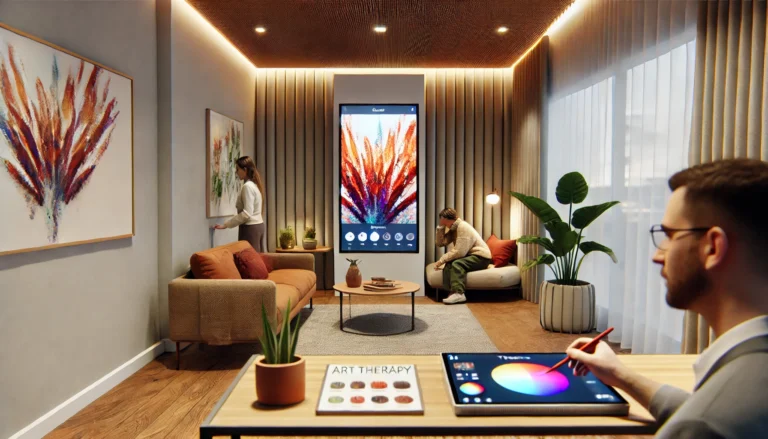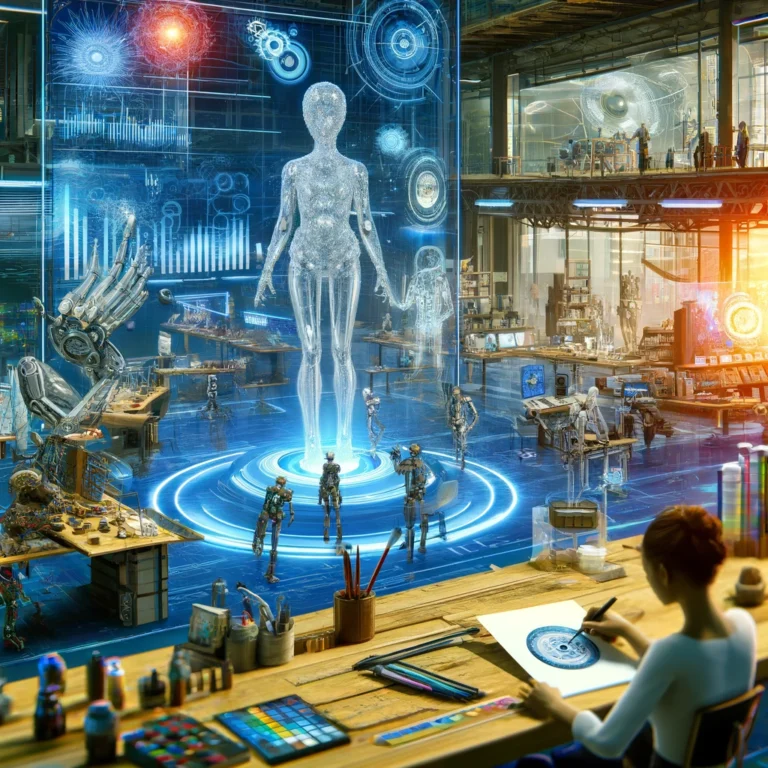The digital landscape is rapidly evolving, and as we delve deeper into the digital era, the user experience (UX) emerges as one of the most pivotal aspects of technological design. With an influx of digital platforms and tools, understanding and optimizing the user’s journey has never been more vital. This article will elucidate why UX is paramount in this digital age, drawing a clear line between designers as artists and designers as problem-solvers, and how technologies like ChatGPT from OpenAI can augment design decisions.
1. The Digital Era: A User-Centric Universe
As we have transitioned into the 21st century, the technological advances and digital innovations have fundamentally changed how businesses and individuals operate. This new digital age is characterized by its hyper-connectedness, the ubiquity of smart devices, and a vast array of digital platforms and tools. But central to this digital transformation is a paramount shift in focus: the rise of the user-centric universe.
i. A Shift in Power Dynamics
In previous eras, producers and companies held most of the power. They would dictate the design, features, and operations of a product, and consumers would adapt accordingly. Today, however, the tables have turned. With the proliferation of choices available to users — from apps to websites to digital services — businesses are no longer the primary force shaping product design or service delivery. Instead, users, equipped with the power of choice and voice (thanks to social media and online reviews), have a significant say in what they want, how they want it, and when they want it. Companies that fail to heed these demands risk obsolescence.
ii. The Age of Personalization
One of the hallmarks of the digital era is the emphasis on personalization. Whether it’s a recommended playlist on Spotify, shopping suggestions on Amazon, or a personalized fitness routine on a health app, users now expect experiences tailored to their preferences and behaviors. This personalization is not a mere luxury but a necessity for businesses wanting to retain and attract customers. As data becomes increasingly available and sophisticated, the ability to offer hyper-personalized experiences becomes a key differentiator in the crowded digital marketplace.
iii. Accessibility and Inclusivity
The digital age doesn’t just cater to the average user; it recognizes the spectrum of users with varying needs and abilities. Digital platforms are now more than ever focusing on inclusivity, ensuring that their designs are accessible to everyone, including those with disabilities. Features like voice commands, screen readers, and adaptable font sizes ensure that the digital realm is open to all, reinforcing the idea of a user-centric universe.
iv. The Demand for Seamless Experiences
As the digital landscape grows, so does the user’s demand for seamless and integrated experiences. They expect to transition smoothly from a mobile app to a desktop site or from an e-commerce platform to a physical store. This emphasis on seamlessness necessitates designs and systems that prioritize the user’s journey, ensuring consistency and ease at every touchpoint.
v. The Feedback Loop
The digital era has also ushered in an age of real-time feedback. Users can instantly review, critique, or praise a product or service. This immediate feedback loop allows companies to iterate and adapt rapidly. It keeps them on their toes, always striving to better serve their users, making user satisfaction central to their operations.
vi. Challenges and Ethical Considerations
While the user-centric universe offers numerous benefits, it’s not without its challenges. Data privacy concerns, the potential for echo chambers due to over-personalization, and the digital divide that leaves certain populations behind are all pressing issues in this era. Addressing these requires a careful balance between user-centric design and ethical considerations.
2. Designers: Beyond Artistic Realms
The realm of design has always been a space where creativity, innovation, and aesthetics converge. Traditionally, designers have been viewed through the lens of artistry — as creators of beauty and visual appeal. However, in the rapidly evolving digital landscape of today, the role of designers has expanded and evolved, transcending the purely artistic to embrace functionality, empathy, and user-centricity.
i. The New Role of the Designer
In the digital age, designers are no longer just the artists; they’re also the problem solvers, the user advocates, and the strategists. They are tasked with understanding complex user needs, behaviors, and motivations and translating them into designs that are not only visually appealing but also functional, intuitive, and user-friendly. This shift has transformed the designer’s role from a creator of beautiful objects to a facilitator of impactful user experiences.
ii. Balancing Art with Functionality
While aesthetics remain a crucial aspect of design, functionality is equally, if not more, important in the digital context. A beautifully designed website or app that fails to deliver its intended purpose or confuses the user is, in essence, a failed design. Designers today must ensure that their artistic inclinations align with the practical needs of the end-users.
iii. Empathy: The Designer’s New Tool
One of the most significant transformations in the design process has been the integration of empathy. Modern designers are trained to immerse themselves in the user’s world, to understand their pain points, desires, and behaviors. This empathetic approach ensures that designs are rooted in real-world needs and not just theoretical or artistic considerations.
iv. The Multidisciplinary Nature of Modern Design
Today’s designers often find themselves at the intersection of various disciplines, from psychology and sociology to technology and business. They collaborate with data analysts to understand user behavior, with marketers to align with brand goals, and with developers to ensure technical feasibility. This multidisciplinary approach emphasizes the designer’s role as a bridge, connecting various facets of a project to ensure its holistic success.
v. Continuous Learning and Adaptation
The digital landscape is characterized by its dynamic nature. New technologies, tools, and user behaviors emerge regularly, necessitating designers to be in a state of continuous learning and adaptation. This proactive approach ensures that they remain relevant and can incorporate the latest trends and technologies into their designs.
vi. Ethical Considerations and Responsibility
With great power comes great responsibility. As designers shape the digital experiences of countless users, they also bear the ethical responsibility of ensuring that their designs are inclusive, accessible, and do not perpetuate harmful biases or stereotypes. The digital age demands that designers be conscious of the broader societal implications of their work.
3. AI: A Partner in Design Decisions
Artificial Intelligence (AI) has permeated various industries, revolutionizing processes, decision-making, and user experiences. One area where its impact is palpably felt is in the domain of design. Far from being a replacement or threat, AI emerges as a complementary tool, augmenting human creativity and offering data-driven insights to refine design decisions.
i. The Synergy of AI and Human Creativity
AI, with its computational power, offers precise, rapid, and vast data analyses, something humans can’t achieve at the same scale. On the other hand, humans bring intuition, emotion, and contextual understanding to the table. The symbiotic relationship between AI and human designers merges the best of both worlds: data-driven insights infused with human intuition and creativity.
ii. Predictive Designing
One of the most significant assets AI brings to the design table is predictive analytics. By analyzing vast sets of user data, AI can forecast user behaviors, preferences, and potential pain points. This predictive power allows designers to proactively tailor designs, making them more aligned with anticipated user needs.
iii. Personalization at Scale
As discussed previously, the digital age values personalization. While designers can craft unique experiences, doing so for millions of users becomes unfeasible. AI, with its machine learning algorithms, can tailor experiences for individual users based on their behaviors, preferences, and interaction histories, achieving personalization at an unprecedented scale.
iv. Enhancing User Testing and Feedback
Traditional design processes involve user testing, collecting feedback, and iterative refining. With AI, this process can be both expedited and enhanced. By simulating user interactions or analyzing real-time user data, AI can pinpoint design inefficiencies, areas of friction, or opportunities for enhancement, providing actionable insights for designers.
v. Generative Design: Expanding the Horizon
Generative design, powered by AI, involves creating numerous design variations based on set parameters and goals. The designer defines the criteria, and the AI proposes a multitude of design solutions, some of which might be beyond human contemplation. This method not only saves time but also pushes the boundaries of design possibilities.
vi. Ensuring Accessibility and Inclusivity
AI tools can audit designs for accessibility, ensuring that digital platforms are usable by people with disabilities. By analyzing designs against accessibility standards, these tools can highlight potential issues or suggest improvements, making the digital world more inclusive.
vii. Ethical Considerations in AI and Design
The integration of AI in design is not without challenges. The data AI relies on can sometimes be biased, leading to designs that unintentionally perpetuate stereotypes or exclude certain user groups. Moreover, over-reliance on AI might stifle human creativity or lead to homogenized designs. Designers must be conscious of these pitfalls, employing AI judiciously and ensuring the final decision always incorporates human oversight and ethical considerations.
4. A Hypothetical Case Study: ‘NexaStream’
The digital streaming landscape has been dominated by a few giants, but every now and then, a newcomer strives to disrupt the status quo. One such hopeful entity was ‘NexaStream.’ With aspirations to compete with industry leaders, NexaStream’s primary weapon in their arsenal was their commitment to a uniquely user-centric design interface. But their journey, dotted with challenges and revelations, serves as a valuable lesson for the design community.
i. Setting the Stage
NexaStream started with a clear vision: to craft a digital experience unparalleled in its visual elegance. Their lead designer, renowned for artistic creations, conceptualized an interface marked by intricate animations, high-resolution imagery, and groundbreaking visual transitions. The internal team was in awe, but the real litmus test was the end-users.
ii. The Realization
Initial user testing, crucial in the design process, revealed unexpected results. Despite being a visual spectacle, many users found the interface overwhelming. Complaints of slow loading times, due to high-resolution elements, were rampant. The animations, while impressive, confounded users, making navigation a tedious task.
iii. Incorporating AI: ChatGPT to the Rescue
Recognizing the discrepancy between design intentions and user reception, NexaStream turned to ChatGPT for assistance. By directing user queries and feedback through this AI system, the design team could collate and analyze user concerns systematically. Patterns emerged, and it was evident: the artistic vision, although commendable, had inadvertently eclipsed user experience.
iv. The Redesign Process
The insights from ChatGPT acted as a compass for NexaStream’s redesign endeavors. The team redefined their design philosophy, aligning it with the user feedback. While it was essential to retain the brand’s unique artistic flavor, user comfort and usability became paramount.
Animations were simplified, making them intuitive. High-resolution imagery was optimized to ensure quicker load times without compromising on quality. The platform’s navigation structure underwent a complete overhaul, focusing on clarity and ease.
v. The Triumph
Post-redesign, NexaStream rolled out its platform once more, and the response was starkly different. Users appreciated the blend of aesthetics with functionality. The platform began to see increased engagement, longer viewing times, and more importantly, positive word-of-mouth spread.
Reviews poured in, with many lauding NexaStream for their ability to listen to feedback and adapt, a quality not always seen in the competitive world of digital streaming. NexaStream, once a newcomer, began to carve a niche for itself.
vi. Broader Implications
NexaStream’s journey underscores a vital lesson for all digital entities. While innovation and artistic expressions are invaluable, they should never overshadow the primary objective: serving the user. In the era of digital abundance, users seek platforms that respect their time, understand their needs, and deliver experiences tailored to them.
Conclusion
As we journey further into the digital era, the emphasis on UX becomes indisputable. Designers, while retaining their artistic inclinations, must prioritize the user above all else. It’s essential to remember that in the vast digital space, users have a myriad of options at their fingertips. A design that doesn’t serve their needs can easily be replaced by one that does. With tools like ChatGPT, designers can make more informed decisions, ensuring that their creations are not just beautiful but also functional, accessible, and user-centric.










